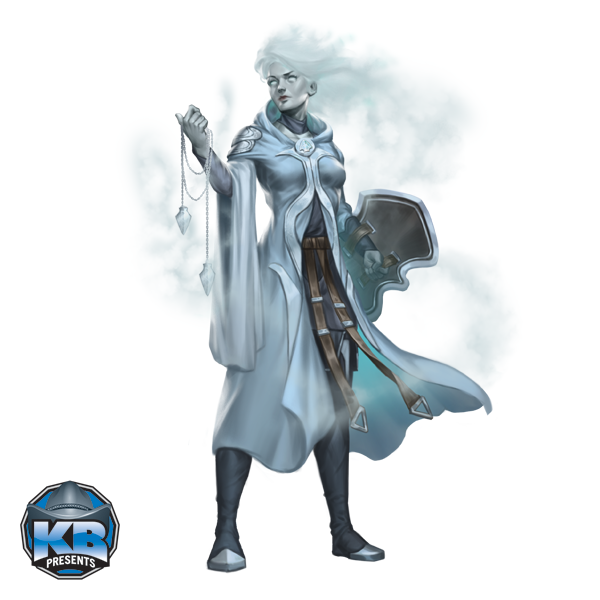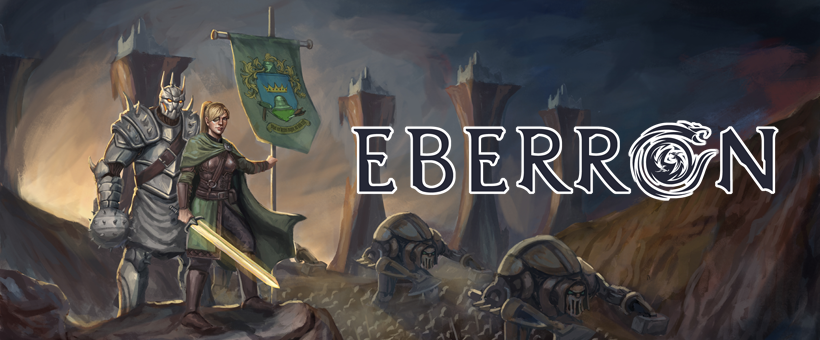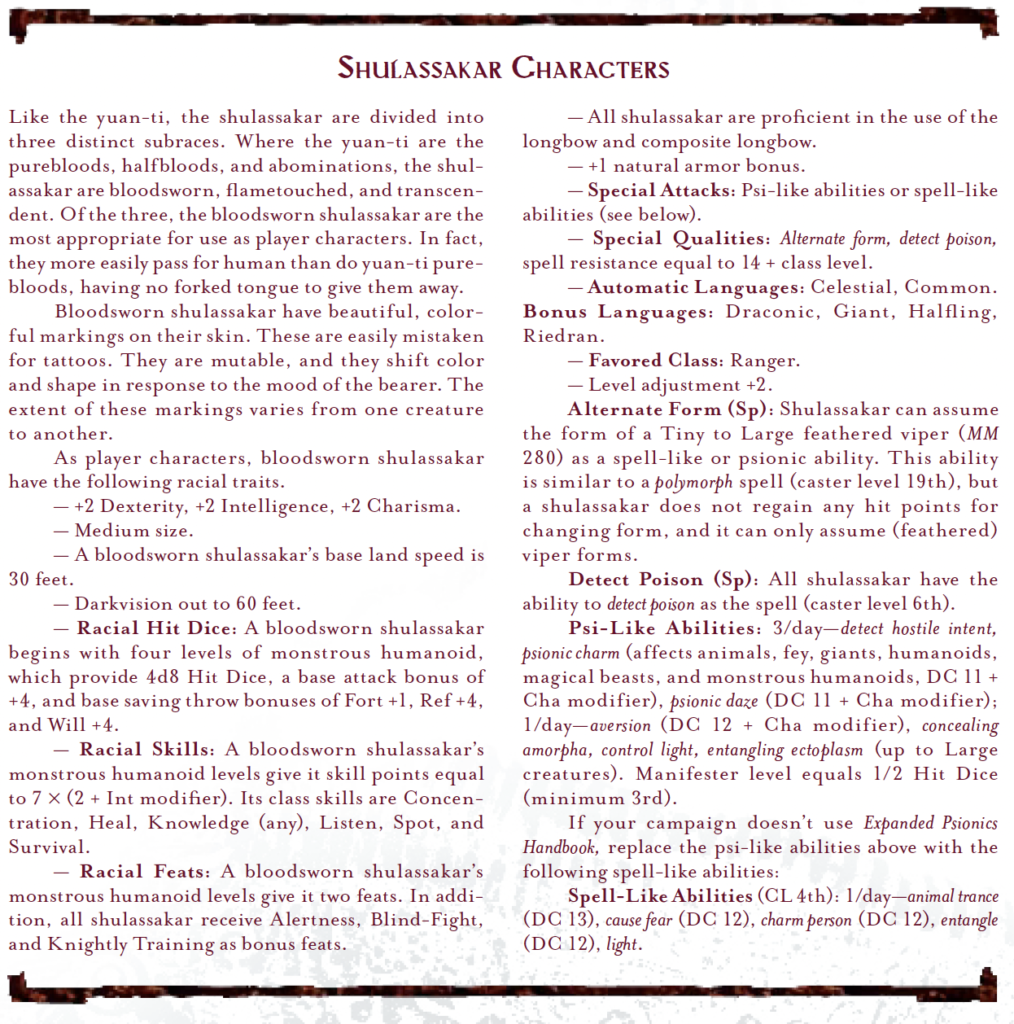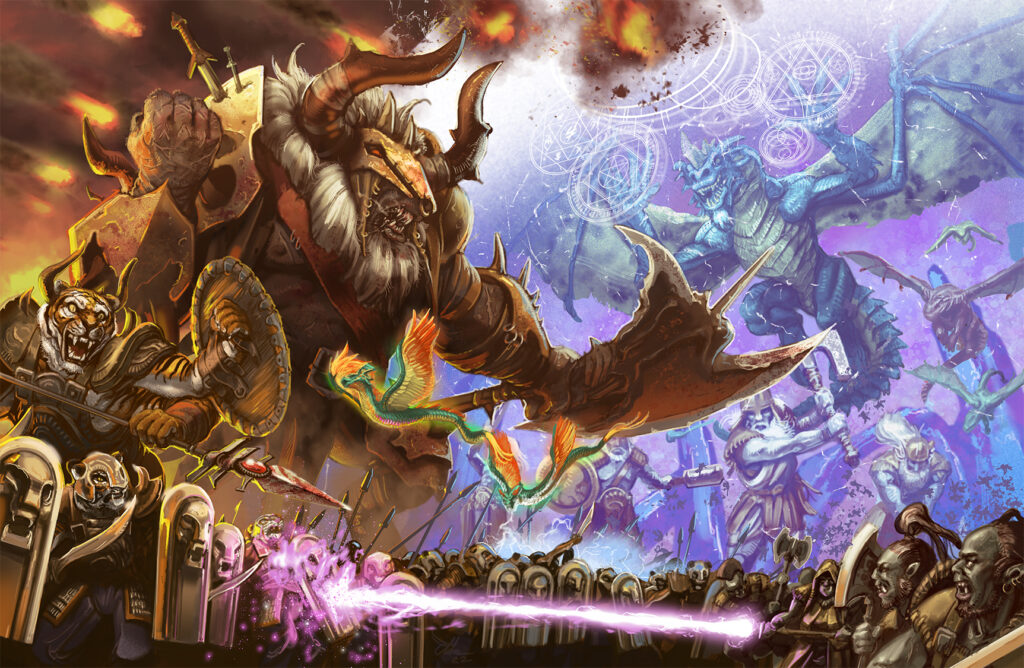
Imagine that your world is a plaything for cruel gods. There’s no escaping them; every corner of reality falls under the dominion of one of these fiendish overlords. Their power manifests in countless horrifying ways. In the domain of the Gatekeeper, you can hear lost souls wailing in the wind… and you know that if you die, yours will join them. In Bel Shalor’s realm, your shadow conspires against you… and some day, it will kill you and claim your body as its own. Dral Khatuur brings slowly advancing, inevitable ice. But the greater and more subtle threats strike at your mind. Within the realm of Rak Tulkhesh you’ll find your anger surging. You find yourself gripping a knife you don’t remember picking up. You keep thinking about your enemies. A week ago you didn’t even know you had enemies… but now it’s hard to think about anything else. The hatred is like fire in your blood, and the only thing that will sate your rage is violence. Perhaps—perhaps you can overcome this brutal haze, to realize that these aren’t your thoughts. But the longer you stay, the more your own memories and motives will fade away in the bloodthirsty fog. This is the power of the overlords. You’ve never seen Rak Tulkhesh, but he’s in you… and soon you’ll be ready to kill for him.
Whether they twist your thoughts or the environment around you, there’s no escaping the influence of the overlords. But you have more direct threats to worry about. To Rak Tulkhesh you’re one of hundreds of thousands of fleas; his hungry wrath sweeps over you, but he won’t manifest personally to strike you down. And he doesn’t have to, because the world is filled with fiends. Some flaunt their horrifying forms and delight in spreading terror and bloodshed; others conceal their true nature and wear the faces of people you love or trust. Demons can possess corpses or beasts… or, for that matter, your body. Perhaps you’ll have to watch as one of Tul Oreshka’s vicious children uses your hands to murder your best friend and then paints a perfect, heartbreaking portrait of them using your fingers and their blood. Fiends could be in the plants around you, in the words you read, in the sword in your hand. If you’re lucky you’ll still have a strong enough sense of self to be able to feel fear and horror at what’s happening around you.
This is life in the Age of Demons. But who are you in this time? You might live in a thatched hut with your extended family. You might be hiding in a network of caves with two other survivors, and you’re pretty sure one of them is possessed. Or you might live in an ancient, crumbling city filled with scheming factions. Your may feel that your time is coming, but the oracle has seen a vision of dragons filling the sky with fire; she says that by nightfall tomorrow, your city will be in ruins. All of this depends on the whims of the overlords. Over the course of a hundred thousand years, the inhabitants of the realm of the Wild Heart have never been anything other than prey. While in the domain of Sul Khatesh there have been a dozen civilizations in that same period, each of which eventually followed a path of arcane science that ultimately destroyed it. But even where you find civilizations, they aren’t free. The subjects of Sul Khatesh can’t resist abusing magic any more than the subjects of Rak Tulkhesh can avoid war. You might ask why Sul Khatesh and her children would do this, why they’d allow a civilization to rise up only to wipe it out in an instant with an arcane cataclysm or over the course of a century through a brutal inquisition. Is it an experiment or art, like the daelkyr? Is it part of a master plan? No. Ultimately, it’s more like food, or perhaps music. The only thing an overlord truly desires is the joy it receives from tormenting mortals. Why? Because mortal souls have power. Gods in some settings need mortals to worship them. In Aerenal, it is the devotion of the living that sustains the Undying Court. The overlords don’t want worship; they want fear, and they want mortals to experience their vision of the world. Rak Tulkesh wants to see hatred and war. Sul Khatesh delights in the fear of magic, and so she creates scenario after scenario in which magic is abused and leads to cruelty, terror, and ultimately destruction. Dral Khatuur wants people to live in fear of the creeping cold. They don’t have an endgame, because they are immortal and endless. They don’t want to ever completely destroy the mortals, because it is torturing mortals that bring them joy. And so it was for millions of years. Some domains saw millions of years of brutal chaos; others saw civilizations rise and fall, but those civilizations were always under the psychic sway of the ruling overlord (whether they knew it or not) and would inevitably be destroyed.
That’s the backdrop to keep in mind when thinking of the Age of Demons. It was a world that was utterly dominated by immortal overlords, where fiends roam freely in the world, both openly and covertly. Civilizations only existed to serve the appetites of the overlords and were wiped out when they lost their savor. Overlords had broadly stable domains, but the borders of their realms were constantly in flux; among other things, the people of a neighboring territory aren’t as used to the terrors of a rival overlord, and their fear is sweeter. Dral Khatuur wants people to fear the advancing ice, not just to learn to survive in it; as such, she would choose to let her borders ebb and flow. The side effect of this is that the overlords were constantly warring with one another.
Now I’ve painted a picture of the Age of Demons, let’s look at a few questions my Patreon supporters have raised this month.
What was the relationship between the Couatls and Dragons during the Age of Demons? Did they respect each other as equals, or did they have conflicts?
The Age of Demons lasted for millions of years. In the final ten thousand years of the Age, there was a powerful draconic nation that called itself Argonnessen. Its disciplined flights of dragons trained to incinerate armies and to raze cities. And these mighty creatures were utterly devoted to the Daughter of Khyber. This overlord is an immensely powerful being. The dragons of the present day have to go to great lengths to avoid falling under her influence, and that’s while she’s bound. During the Age of Demons she was at the height of her power, and the dragons were her tools; she used them to terrify mortals and to attack the domains of other overlords. So there was no powerful nation of dragons that fought the overlords, because any powerful force of dragons would be corrupted by the Daughter of Khyber. The dragons opposing overlords were a small band of scrappy rebels who had been shielded from the influence of the Daughter of Khyber by their allies, the native celestials. Let’s consider each of those forces.
NATIVE CELESTIALS
It’s said that Khyber created fiends, Siberys created celestials, and Eberron created natural life. But Khyber slew Siberys. This is why the native celestials are so much weaker than their counterparts, and why there are no celestial equivalents to the overlords. The celestials that exist are just a faint echo of what would have been had Siberys had an active hand.
Native celestials embody the broad concept of goodness in the world. Compassion, justice, defense, wisdom, love; these are the sorts of concepts personified by the celestials. Just as the fiends exist to prey upon and terrify mortals, the purpose of the celestials was to guide and protect them. Given that the celestials were massively overpowered and outnumbered by the fiends, this was something they did subtly—working to inspire people or to guide key mortals who could help others… teaching people to fish rather than giving them fish. Whenever celestials were exposed, fiends would swarm in to destroy the interlopers and whatever they had accomplished; subtlety was vital. However, keep this section from Chronicles of Eberron in mind…
Glance across a Khalesh plain and you may see what looks to be a giant bone projecting from the earth—a fallen column of something like polished ivory. The locals call these “dragon bones,” saying they’re the bones of Eberron herself. But search further and you may find patches of wall, foundations, or even small buildings formed from this dragonbone. It’s virtually indestructible and seemingly immune to the passage of time. In truth, this isn’t made from the bones of the earth; it’s a building substance used by the ancient couatl, the most numerous of the native celestials of Eberron. Khalesh is one of the places that the couatl came into the world in the Age of Demons, one of the anchors where these immortals would reform if they were destroyed. In a sense, it’s the celestial counterpart to the Demon Wastes of Khorvaire; a place suffused with lingering celestial power.
The fiends vastly outnumbered the celestials, and over the course of millions of years they learned where most of these celestial anchors were. But they couldn’t actually DO anything about them. The celestials are as immortal as the fiends, and when destroyed they would eventually return. Given a good reason—for example, if the couatls tried to foster a mortal civilization in their spire—the fiends would bring sufficient forces to bear to destroy everything in a celestial spire. While the immortals would return the mortals would be lost. For that reason, the celestials kept their work subtle, working with individuals or small groups of mortals who then worked with others. The celestial guides could shield mortals from the psychic influence of the overlords. They could teach them, helping mortals master magic or other skills. They could even channel their power into a mortal, a form of voluntary possession. However, throughout most of the Age of Demons, they were never able to affect any grand change. The final rebellion wasn’t the only rebellion; it’s just the only one that had lasting results.
While it’s never been mentioned in canon, in my Eberron Flamekeep is built on dragonbone foundations and that the font of the Flame is a celestial anchor point. Likewise, there is a celestial anchor in the Labyrinth around the Demon Wastes; this is a sacred haven of the Ghaash’kala orcs.
Throughout this I’ve been saying celestials instead of couatls. Any celestial statblock could be reskinned to reflect a native celestial of Eberron. Just as the native fiends have a certain fondness for feline forms, the native celestials often have some blend of serpentine features or prismatic feathers. The couatl are by far the most common form of native celestial, but adventurers could encounter a deva with rainbow wings or a ki-rin with prismatic scales and a serpentine head. Compared to their counterparts in Shavarath or Syrania, these celestials are still guided by the basic principle of embodying positive ideas—of protecting and inspiring mortals as the Silver Flame continues to do today. Throughout most of the Age of Demons, these native celestials were only loosely aligned and largely sought to express their nature as individuals. They didn’t try to act as a host, because all that would accomplish would be creating a target to rally the fiends; they worked subtly and on their own. Which brings us to…
DRACONIC CHAMPIONS OF THE AGE OF DEMONS
In the last era of the Age of Demons, Argonnessen was a tool of the Daughter of Khyber. But there were small groups of dragons who evaded the Daughter’s control—first through celestial intervention, and then through the use of rituals and spells that they created. Dragons possess innate arcane power. The celestials helped the dragons understand their potential, but the rebels developed their own tools and techniques. Different cells specialized in different things. Dularanahk and her brothers led groups of warrior dragons and titans, capable of unleashing devastating force when it was required. Ourelonastrix worked with a cabal of dragons studying arcane science. Think of this as a hacker collective that provided logistical support and facilitated communications between the cells. All of this built on the work of previous generations; Ourelonastrix didn’t single-handedly master the secrets of arcane magic. But working with the couatl Hezcalipa, he made a crucial breakthrough that would ultimately bring the Age of Demons to an end: he discovered the Draconic Prophecy. What followed likely took centuries, as Ourelonastrix rallied the disparate dragons and Hezcalipa called on scattered celestials to help find Prophecy signs, gathering enough data to understand the power and possible paths of the Prophecy. Up to this point, the rebels had no real goal other than survival; without a way to permanently defeat an overlord, there was no reason to start a war. Now there was a glimmer of hope—a path through the Prophecy that could lead to victory.
The dragons who challenged the overlords weren’t a nation or a massive army. They were remarkable individuals, leading small bands of other remarkable mortals—including dragons, giants, titans and more. Ourelonastrix was the greatest expert on magic and knowledge. The Dols led militant cells, while Kolkonoran facilitated logistics and support, moving supplies between the cells. Eventually the studies of the Prophecy revealed a possible path to victory. And this is when the war began in earnest. This is where we have Dularanahk facing the Lord of Death, and other clashes in which the rebels gathered all their military might together—because they needed to win battles, acquire artifacts, or even potentially to lose key battles in order to lock in the future Ourelonastrix had discovered. The final key element was the sacrifice of the celestials to create a force that could bind the overlords. But even this wasn’t an instant victory. Once the celestials kindled the Silver Flame, the overlords were severed from their heart demiplanes; when their avatars were destroyed their essence would be bound into the prison shards. But each one had to be individually defeated… and even though they were weakened, this was no small task, especially without the help of the departed celestials. The first target was the Daughter of Khyber; once she was bound in the Pit of Five Sorrows, her hold over Argonnessen was broken. And now there was a true army of dragons fighting to bring down the remaining overlords, one by one.
OK… BUT WHAT ABOUT THE RELATIONSHIP BETWEEN THEM?
The original question was What was the relationship between the Couatls and Dragons during the Age of Demons? Did they respect each other as equals, or did they have conflicts? The important thing to understand is it wasn’t about the relationship between THE DRAGONS and THE CELESTIALS. It was about the relationship between Ourelonastrix and Hezcalipa, between Dularanahk and Azcalanti, and others. Because you aren’t talking about nations, you’re talking about remarkable individuals. Within that framework, it was the purpose of the celestials to guide and protect the mortals. There were many conflicts between them—disagreements over actions that endangered innocents, dragons believing the celestials were holding back, celestials trusting tradition while Ourelonastrix urged them to follow his instincts. Likewise, there were celestials who opposed the sacrifice that kindled the Flame, even if they ultimately took part. But again, these agreements and disagreements were between individuals, not cultures. While the celestial anchors resemble cities, the couatl never had a nation.
You’ve mentioned native celestials… What are native fiends like?
Fiends are incarnations of evil concepts. In the planes, they are tied to the central idea of their plane. A Shavaran devil reflects the idea of evil in war. A Daanvi devil embodies tyranny or oppressive order. A Fernia balor represents the cruel, chaotic destruction of fire. The native fiends more broadly represent evil in the world. Their purpose is to tempt and torment mortals, wreaking Khyber’s vengeance against the children of Eberron with a hundred thousand tiny cuts. All native fiends are tied to Khyber; most are specifically part of an overlord and its heart demiplane, but there are some time to demiplanes without overlords. Native fiends generally reflect an aspect of their overlord’s defining concept. Fiends tied to Rak Tulkhesh are tied to some aspect of hatred or war. Those associated with Sul Khatesh are more likely to be associated with magic or dangerous secrets. However, they can approach this in different ways. A raskhasa serving Rak Tulkhesh may excel at inspiring mortals to go to war—using its talents for deception to set conflict in motion. While a goristro bound to Rak Tulkhesh is a fiendish engine of war waiting to be unleashed on the battlefield.
A goristro? Absolutely. Just as couatl are the most common celestials but not the only celestials, rakshasa are the most numerous of the fiends but far from the only ones. Any fiendish stat block could be used for a native fiend, with a little cosmetic reflavoring. In the image that accompanies this article, the multiarmed figure on the left is a native marilith. Feline features are in fashion among the native fiends, but in describing a fiend, don’t feel you need to make it mundane. What differentiates a rakshasa from a weretiger? Canonically, the rakshasa Mordakhesh has stripes of blazing flame across his black fur. The First Scribe, Hektula, has arcane sigils on her fur. Remember that fiends aren’t natural creatures; when they are revealed in their full power, they should have obviously supernatural aspects.
Beyond this, I’ve suggested that feline features are a fashion. Rakshasas are natural shapechangers, and they are immortal embodiments of ideas, not creatures of flesh and blood. There may have been a time when the Lords of Dust wore shark heads, or even draconic features; the present use of feline features may be a fun retro reference to the Age of Demons. With this in mind, when adventurers in my game use True Seeing on a fiend, they don’t see its tiger form. Someone looking at Mordakhesh with Truesight will see him as a figure of shadows striped in flame and as a bloodthirsty sword, all at once. They will see that he has killed tens of thousands with his own hands, and feel his all-consuming appetite for war. Because THAT is the truth of Mordakhesh. For fiends and celestials, truesight doesn’t just strip away disguise self; it reveals their truth. Depending on the power of the fiend and the circumstances, I may make the individual with Truesight make a saving throw to avoid psychic damage or a condition; it can be dangerous to look too closely at a powerful immortal.
Just for fun, here’s a table you can use to add some random flare to a rakshasa or other native fiend…
Fiendish Features
| d8 | ||
| 1 | Burning | Stripes |
| 2 | Bloody | Horns |
| 3 | Steel | Teeth |
| 4 | Shadowy | Scales |
| 5 | Oozing | Talons |
| 6 | Icy | Eyes |
| 7 | Rotting | Wings |
| 8 | Many | Tentacles |
Was there a time before the Age of Demons?
There was a brief time, yes. If you believe the myth, Eberron defeated Khyber by constricting her and then becoming the world. The principle is that Khyber’s children were able to slip through Eberron’s coils. But this wouldn’t have happened instantly, and even once the overlords were out in the world it surely took some time for them to sink their roots into reality and to establish their dominions. So, there was a period in which natural life flourish before being dominated by the overlords. What was it like? Who knows. Keep in mind that this was millions of years ago and that most likely, cultures didn’t appear fully formed. How long did it last? Were there any significant cultures in place before the overlords claimed the world? Largely, that’s a question you need to answer based on the needs of your story. Morgrave professor Cord Ennis suggests one possibility in this article about sphinxes:
While intriguing, Ennis admitted that there was one piece of the puzzle that still escaped him. When do these time-traveling sphinxes come from? His first thought was the distant future—that they could even be some sort of mystically evolved descendants of the modern races. Yet if that were the case, is there no risk of their meddling changing their own future? Given this, he ultimately favors the idea that the sphinxes are from the very distant past—that they could potentially be the citizens of the FIRST civilization of Eberron, a society that predates the Age of Demons and whose existence was wiped from history by the dominion of the overlords. With this as a foundation, Ennis suggests that the actions of the sphinxes might not be the absolute demands of destiny one would expect from embodiments of the Prophecy, but rather a grand game. As their time is long past, the sphinxes don’t actually care about the ultimate outcome; whether the overlords rise again or the daelkyr are unleashed doesn’t actually hurt them. Ennis further suggests that this could reflect the different techniques seen among sphinxes. The “divine” sphinxes—those wielding clerical abilities—could see their actions as being a divine mission, potentially even one mandated by the Progenitors (because what other gods were there at the dawn of time?) while the “arcane” sphinxes could be the scientists of their time. Thus, Flamewind could be in Sharn because she knows it is a nexus of elements she wants to deal with—events or people she wants to observe or influence—but that between those key events she is simply enjoying studying this time and place, so alien to her native time.
The key point of this idea is that the Sphinx civilization is so far back in time that no evidence of it remains, and that its downfall is utterly inevitable. The sphinxes can’t save themselves; all they can do is to play games in the future.
That’s all for now! I have very limited time at the moment and most likely will not answer questions posted in the comments, but feel free to discuss them yourselves. I do answer questions on my Patreon, and in fact, I will be hosting a live Q&A on my Patreon Discord at 9 AM Pacific Time on Saturday, July 22nd. So check out my Patreon if you want to participate in that! Your support directly determines how much time I can spend creating Eberron content, so thanks to my current patrons for making this article possible.

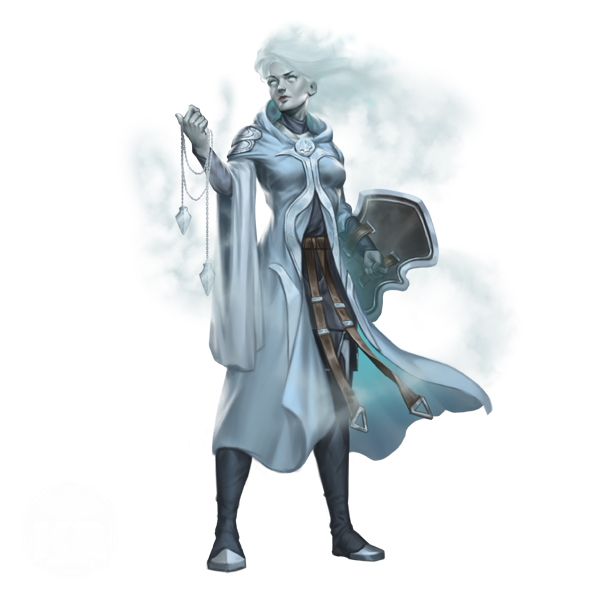
 Unlock with Patreon
Unlock with Patreon